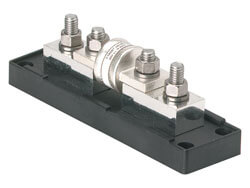timselectric
If I can do it, you can do it.
- Joined
- Feb 5, 2022
- Messages
- 18,637
When using buss bars like that, it's not that critical to connect to opposite corners. It's not like multiple connections with wires and lugs.
That is only true if the bus bars are very heavy duty (and therefore offer little resistance). I just assume they are not heavy enough and hook things up diagonally.When using buss bars like that, it's not that critical to connect to opposite corners. It's not like multiple connections with wires and lugs.
I've went ahead and installed 150A MRBF fuses and 300A BlueSea terminal blocks on my 3 EG4 batteries.I don't trust those breakers.
I asked their support and he said he would get back with an answer and has not yet replied.
Until he does I will recommend a class t breaker as close as possible to the positive battery terminal.
MRBF fuses only have an AIC of 2,000 amps at 58 volts.I've went ahead and installed 150A MRBF fuses and 300A BlueSea terminal blocks on my 3 EG4 batteries.
Good video.I'd like to see Signature Solar or Will intentionally short the EG4 to see how the breaker performs.
Similar to this.
Others in the video comments had the same hypothesis. Basically calling the 8awg wire a big resistor.I have an hypothesis.
400ah * 100c / 2 pack resistance(WAG) = ~20000 dead short amps
The voltage drop over 15 feet of 8 awg copper at 20000 amps is going to be massive.
As the voltage drops the the fuse's AIC goes up.
Welcome to my world.OK... now your freaking me out, I have 6 of the eg4s
Welcome to my world.
I like what the SOK rack battery did with including an internal Class T fuse. Solved a bunch of questions.
I don't know if I have the space to include 3 other big honking Class T fuse holders. I went with MRBF fuses because it seemed a reasonable alternative. There is a breaker but I'm leary of someone just saying "yeah, those Chinese breakers are fine."
So far I have the 125A battery breaker, MRBF fuses on each battery, a 300A Class T protecting the entire battery bank and a 250A 125VDC heavy duty breaker as a disconnect switch.
In your case, (6) Class T fuses and holders would set you back about $85 each. Plus another for the entire bank. 7x$85 = $595

I trust a Fet based bms about as much as I trust that breaker.I've seen video of applying over current to the EG4. The BMS shut down at 213 amps. The breaker never tripped.
That was a factor in my reasoning for using the MRBFs. I'd prefer to not use the BMS as first defense protection device.
I'm surprised that you trust a fuse. lolI trust a Fet based bms about as much as I trust that breaker.
I've seen video of applying over current to the EG4. The BMS shut down at 213 amps. The breaker never tripped.
That was a factor in my reasoning for using the MRBFs. I'd prefer to not use the BMS as first defense protection device.
I trust a Fet based bms about as much as I trust that breaker.
I'm surprised that you trust a fuse. lol
If for some reason the breaker didn't trip. The BMS, would shutdown or the fets would burn. I don't have to trust the breaker, it's not the weakest link.
So far I have the 125A battery breaker, MRBF fuses on each battery, a 300A Class T protecting the entire battery bank and a 250A 125VDC heavy duty breaker as a disconnect switch.
Is this your topo?So far I have the 125A battery breaker, MRBF fuses on each battery, a 300A Class T protecting the entire battery bank and a 250A 125VDC heavy duty breaker as a disconnect switch.
positive
|<->class_t_fuse<->rest_of_system
|-dead_short------------------------------->|
|<->mrbf_fuse<->breaker<->battery.1<->bms<->|
|<->mrbf_fuse<->breaker<->battery.2<->bms<->|
rest_of_system<->shunt<->|
negativeIf you trust the breaker then the fuse is superfluous, right?I trust the fuse and breaker.
Yesyou trust the breaker then the fuse is superfluous, right?
The breaker doubles as a disconnect. And could possibly save the BMS.Do you trust the BMS, if yes then the breaker is superfluous, right?


